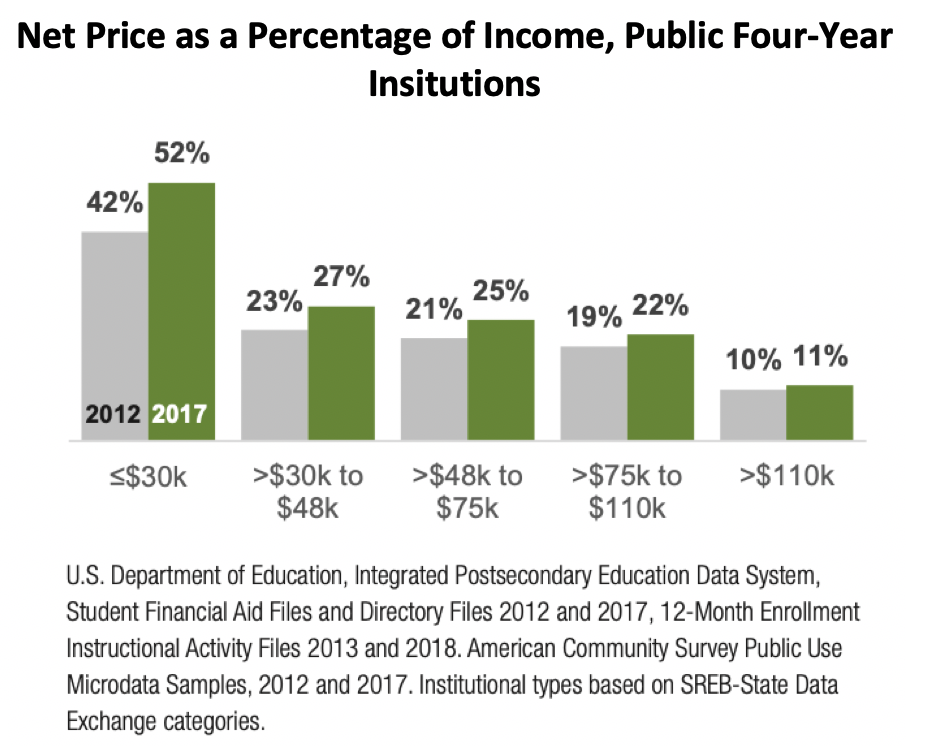THE NEED
DISPROPORTIONATE STUDENT DEBT INCREASES BLACK/WHITE RACIAL WEALTH GAP
In North Carolina the average student borrower under 25 owes $15,962 in federal student loans. After completing college, the average North Carolina student borrower graduates with $26,129 in student loan debt.[1] According to findings by the North Carolina Institute of Minority Economic Development, college students of color in America are disproportionately strapped down by mounting student debt compared to other racial and ethnic groups. The report finds that in 2016, 82% of Black students who attended a 4-year public university and 87% who attend a 4-year private non-profit university were indebted due to undergraduate student loans. In U.S. dollars, this is $30,125 for 4-year public universities and $36,141 for 4-year private non-profit universities. Further, young Black adults take on 85% more debt to pay for their education compared to their white counterparts, according to Forbes. [2] Overall, Black students take on more college debt and default within 12 years of entering college. Students attending HBCUs borrow at a greater rate than students attending non-HBCUs, at a rate of 80% and 55%, respectively.[3] To fund their education, 25% of students attending HBCUs borrow $40,000 or more compared to only 6% of non-HBCU students.[4] The impact of the burden of student debt on Black students contributes to a quarter of the Black-White racial wealth gap, with Blacks’ having a net wealth of $19,190 at age 30 compared to Whites’ net wealth of $75,768. [5]
INCREASING IMPORTANCE OF A COLLEGE DEGREE
According to the Bureau of Labor Statistics, about 40 percent of jobs between 2019-2029 will require a bachelor’s degree and 46 percent will require a master’s, doctoral, or professional degree, compared to only 37% of non-college jobs. [6]
DECREASE IN COLLEGE AFFORDABILITY
HBCUs enroll 71% of low-income students compared to 39% of non-HBCUs.
For families making less than $30,000, 52% of their income in 2017 was needed to pay for educational expenses, an increase from 42% in 2012. [7] Families making over $110,000 only need 11% of their income in 2017.
The maximum Pell Grant percentage of college costs has decreased from 72% in 1977 to 30% in 2016 for four-year public universities and 35% in 1977 to 13% in 2016 for four-year private non-profit universities.[8]
Students attending HBCUs have an average unmet need of $9,855 compared to an unmet need of $7,810 for non-HBCU students.[9]
[1] “Federal Student Loan Portfolio | Federal Student Aid,”, https://studentaid.gov/data-center/student/portfolio.
[2] Kori Hale, “Biden Cancelling Student Loans Could Close The Racial Wealth Gap,” Forbes, https://www.forbes.com/sites/korihale/2020/12/08/biden-cancelling-student-loans-could-close-the-racial-wealth-gap/.
[3] “Infographic: Fewer Resources, More Debt: Loan Debt Burdens Students at HBCUS,” UNCF (blog), https://uncf.org/pages/infographic-fewer-resources-more-debt-loan-debt-burdens-students-at-hbcus.
[4] “Infographic: Fewer Resources, More Debt: Loan Debt Burdens Students at HBCUS.”
[5] Annie Nova, “Racial Wealth Inequality Is Worsened by Student Debt, Study Finds,” CNBC, September 26, 2018, https://www.cnbc.com/2018/09/26/for-african-americans-student-debt-makes-college-more-of-a-risk.html.
[6] Elka Torpey, “Education Level and Projected Openings, 2019–29 : Career Outlook: U.S. Bureau of Labor Statistics,” https://www.bls.gov/careeroutlook/2020/article/education-level-and-openings.htm.
[7] North Carolina, “At Four-Year Institutions than Two-Year Institutions,” 2020, 9.
[8] “Infographic: Fewer Resources, More Debt: Loan Debt Burdens Students at HBCUS.”
[9]“Infographic: Fewer Resources, More Debt: Loan Debt Burdens Students at HBCUS.”

